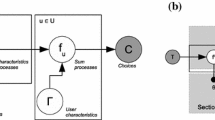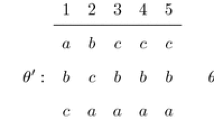Abstract
We propose a directed graph for testing whether observed household consumption behavior satisfies the Collective Axiom of Revealed Preferences (CARP). More precisely, the data satisfy CARP if the graph allows a node-partitioning into two induced subgraphs that are acyclic. We prove that partitioning the obtained graph into two acyclic subgraphs is NP-complete. Next, we derive a necessary condition for CARP that can be verified in polynomial time, and we present an example to show that our necessary and sufficient conditions do not coincide. We also propose and implement fast heuristics for testing the sufficient condition. These heuristics can be used to check reasonably large data sets for CARP, and can be of particular interest when used prior to computationally demanding approaches. Finally, based on computational results for both real-life and synthetic data, we conclude that our heuristics are effective in testing CARP.
Similar content being viewed by others
References
Afriat S. (1967) The construction of utility functions from expenditure data. International Economic Review 8: 67–77
Ahuja R., Magnanti T., Orlin J. (1993) Network flows: Theory, algorithms, and applications. Upper Saddle River, NJ, Prentice Hall
Blow L., Browning M., Crawford I. (2008) Revealed preference analysis of characteristic models. Review of Economic Studies 75: 371–389
Brown D., Matzkin R. (1996) Testable restrictions on the equilibrium manifold. Econometrica 64: 1249–1262
Brown D., Shannon C. (2000) Uniqueness, stability and comparative statics in rationalizable walrasian markets. Econometrica 68: 1529–1540
Browning M., Chiappori P. (1998) Efficient intra-household allocations: A general characterization and empirical tests. Econometrica 68: 1241–1278
Carvajal A., Ray I., Snyder S. (2004) Equilibrium behavior in markets and games: Testable restrictions and identification. Journal of Mathematical Economics 40: 1–40
Chang G., Chen C., Chen Y. (2004) Vertex and tree arboricities of graphs. Journal of Combinatorial Optimization 8: 295–306
Chen Z. (2000) Efficient algorithm for acyclic colorings of graphs. Theoretical Computer Science 230: 75–95
Cherchye L., Crawford I., De Rock B., Vermeulen F. (2009) The revealed preference approach to demand. Chapter 9 in quantifying consumer preferences: Estimating demand systems. In: Slottje D. Contributions to economic analysis. Emerald Press, UK
Cherchye L., De Rock B., Sabbe J., Vermeulen F. (2008) Nonparametric tests of collectively rational consumption behavior: An integer programming procedure. Journal of Econometrics 147: 258–265
Cherchye L., De Rock B., Vermeulen F. (2007) The collective model of household consumption: A nonparametric characterization. Econometrica 75: 553–574
Cherchye L., De Rock B., Vermeulen F. (2008) Analyzing cost efficient production behavior under economies of scope: A nonparametric methodology. Operations Research 56: 204–221
Cherchye L., De Rock B., Vermeulen F. (2010) An Afriat theorem for the collective model of household consumption. Journal of Economic Theory 145: 1142–1163
Chiappori P. (1988) Rational household labor supply. Econometrica 56: 63–89
Chiappori P. (1992) Collective labor supply and welfare. Journal of Political Economy 100: 437–467
Chiappori P., Ekeland I. (2006) The micro economics of group behavior: General characterization. Journal of Economic Theory 130: 1–26
Chiappori P., Ekeland I. (2009) The micro economics of efficient group behavior: Identification. Econometrica 77: 763–800
Christensen, M. (2007). Integrability of demand accounting for unobservable heterogeneity: A test on panel data. IFS Working paper W14/07, University of Manchester.
Chung-Piaw, T., & Vohra, R. (2003). Afriat’s theorem and negative cycles, mimeo, Northwestern University.
Deb R. (2008) Acyclic partitioning problem is NP-complete for k = 2. Private communication. Yale University, United States
Deb, R. (2008b). An efficient nonparametric test of the collective household model, Working paper. Yale University, United States.
Diewert E. (1973) Afriat and revealed preference theory. Review of Economic Studies 40: 419–425
Dobell A. (1965) A comment on A. Y. C. Koo’s an empirical test of revealed preference theory. Econometrica 33: 451–455
Donni, O. (2008). Household behavior and family economics. The Encyclopedia of Life Support Systems Contribution 6.154.9.
Gross L., Yellen J. (2004) Handbook of graph theory. CRC Press, Boca Raton, FL
Lundberg, S., & Pollak, R. (2007). Family decision-making. The New Palgrave, dictionary of economics, 2nd Edn. forthcoming.
Starr R. (1969) Quasi-equilibria in markets with non-convex preferences. Econometrica 37: 25–38
Starret D. (1972) Fundamental nonconvexities in the theory of externalities. Journal of Economic Theory 4: 180–199
Talla Nobibon, F., Hurkens, C., Leus, R., & Spieksma, F. (2009). Coloring graphs to avoid monochromatic cycles. Manuscript, University of Leuven.
Varian H. (1982) The nonparametric approach to demand analysis. Econometrica 50: 945–974
Varian H. (2006) Revealed preference. In: Szenberg M., Ramrattan L., Gottesman A.A. (eds) Samuelsonian economics and the 21st century. University Press, Oxford
Author information
Authors and Affiliations
Corresponding author
Rights and permissions
About this article
Cite this article
Talla Nobibon, F., Cherchye, L., De Rock, B. et al. Heuristics for Deciding Collectively Rational Consumption Behavior. Comput Econ 38, 173–204 (2011). https://doi.org/10.1007/s10614-010-9228-9
Accepted:
Published:
Issue Date:
DOI: https://doi.org/10.1007/s10614-010-9228-9




